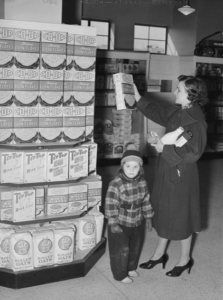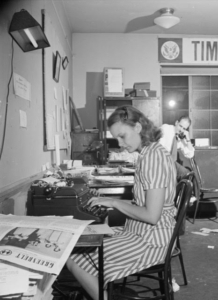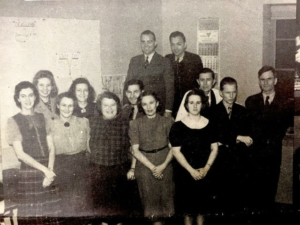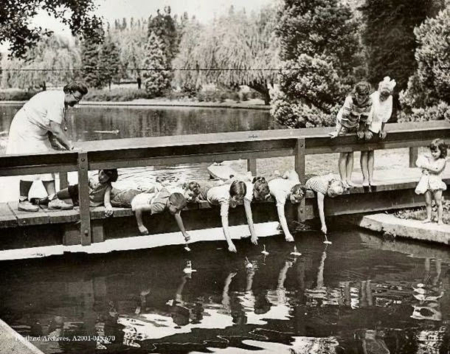
Shopping at Greenbelt Cooperative Grocery Store
Cooperatives remain central to life in Greenbelt today. Photo by Russell Lee, 1938. Courtesy, Library of Congress Prints and Photographs Division Washington, D.C.
In 1937, Theodora and John Murray were among 850 families selected to reside in an experimental city built and owned by the federal government.
About a half-hour’s drive from Washington, DC., Greenbelt, Maryland is one of three planned residential communities conceived and developed by the New Deal’s Resettlement Administration (RA), which relocated displaced and low-income families during the Great Depression. These Greenbelt towns, described as “utopian” by both adherents and detractors alike, offered affordable rents in suburban villages meant to deliver families from blighted urban housing.
“They wanted to try an experiment that provided something healthy, with lots of green grass and trees,” says Greenbelt journalist Mary Lou Williamson, a 60-year city resident of the town. “There was plenty of fresh air and children could spend time outside in a safe community.”

Mary Lou Williamson, a 60-year resident of the town, reported on the public hearings that led real estate developer Charles Bresler to sue the Greenbelt News Review for criminal libel. The case went all the way to the U.S. Supreme Court. Photo by Susan Ives, 2022.
Prospective tenants were screened not only on the basis of income, but on their prospective suitability for starting a cooperative community. “They wanted people who would take care of things,” Williamson explains.
The Murrays and other Greenbelt townsfolk decided to start with a town newspaper. Churned out on a mimeograph machine, “The Cooperator,” became a vital part of promulgating “the Greenbelt philosophy.” Besides guiding new residents through a maze of organizational meetings, its editors and reporters encouraged readers to view themselves as “pioneers” of a new way of life, and promoted the city as a “model for future Greenbelts.”
Organized as a cooperative, the newspaper ushered in a proliferation of other co-ops. A credit union, grocery store, nursery school and babysitting co-op remain active today. The New Deal Café, a hive of activism, is cooperatively managed by town residents.

Mrs. Hoover reading the Greenbelt Cooperator in her living room.
The paper, published by the Greenbelt Cooperative Publishing Association, Inc., was established in 1937 shortly after the federal government’s construction of Greenbelt. It has been published weekly without interruption ever since and is delivered free to most Greenbelt residents. Photo by Marjory Collins, 1942. Courtesy, Library of Congress Prints and Photographs Division Washington, D.C.
Critics of FDR’s Administration denounced the so-called “green towns” as a socialist boondoggle. But it wasn’t until after WWII that Greenbelt and its newspaper met with an existential threat, when Wisconsin Senator Joseph McCarthy proposed selling the three green towns to private interests. Greenbelt tenants narrowly voted to purchase the homes collectively and established a cooperative, Greenbelt Homes, Inc., in 1954.
McCarthy’s scrutiny had bred fear and distrust. Not long after Greenbelt was targeted during televised hearings of the House Un-American Activities Committee, The Cooperator changed its name to the Greenbelt News Review.
In 1965, real estate developer Charles Bresler and the city became embroiled in a zoning dispute.
At a heated city council meeting, a Greenbelt resident accused Bresler of trying to “blackmail” the city into a decision Bresler sought. News Review reporter Mary Lou Williamson, who would later become the paper’s editor, reported on the controversy and criticisms leveled at Bresler. He sued the News Review for criminal libel in what became a precedent-setting lawsuit.

Sally Meredith, reporter for the Greenbelt Cooperator
Photo by Marjory Collins, 1942. Courtesy, Library of Congress Prints and Photographs Division Washington, D.C.
In 1970 the Supreme Court unanimously decided in the News Review’s favor, holding that reporting the news is protected by the First Amendment, and that the paper was not libelous for accurately reporting such “rhetorical hyperbole” at a lively public meeting,” but rather “was performing its wholly legitimate function as a community newspaper when it published full reports of these public debates in its news columns.”
Greenbelt Cooperative Publishing v Bresler (1970), “is a very important case,” says Washington D.C. attorney Lee Levine, who has argued libel cases before the Supreme Court. “Both for what it decided…and for the influence it’s had on the law since.”

Volunteer staff at The Cooperator
The weekly paper was renamed the Greenbelt News Review in 1954. In 1970, The News Review successfully defended the freedom of the press before the U.S. Supreme Court.
Photographer unknown.
The precedent established by Greenbelt’s hometown paper continues to guarantee freedom of the press. In a 1990 case, Milkovich v The Lorraine Journal, the Court reiterated its finding in the Greenbelt case of “rhetorical hyperbole” as protected speech under the First Amendment and expanded press protection against frivolous, but costly, lawsuits.
Watch: PBS segment about Greenbelt in “Ten Towns That Changed America”
(5 minutes)
Watch: “Defending Utopia, The Greenbelt News Review at 80,” a film by Susan Gervasi
Film: https://vimeo.com/285905039. (48 minutes)
Trailer: https://vimeo.com/257268409
Susan Gervasi is a journalist and documentary filmmaker based in the Washington, D.C. area. Her articles have appeared in the Washington Post, Washington City Paper, the New York Daily News and numerous other publications. Her films include Defending Utopia: the Greenbelt News Review at 80; Psychedelic Mysticism: The Good Friday Experiment & Beyond; On the Trail of Jack Thorp; and Mary Surratt: Mystery Woman of the Lincoln Assassination.








